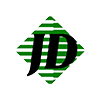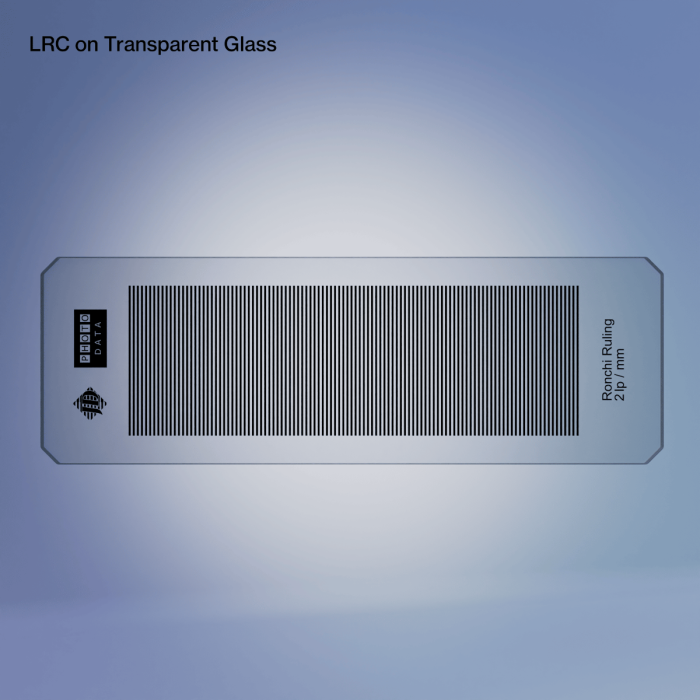SL6 Ronchi Rulings Test Target
For evaluating resolution and field distortion
75mm x 25mm x 1.5mm
5lp/mm up to 500 lp/mm
Precision Ronchi Ruling Glass slides are excellent for evaluating resolution, field distortion, and parfocal stability, especially of microscopes. Many different Linepairs Per Millimeter (LP/MM) versions available from 5lp/mm upto 500 lp/mm. A linepair is described as one dark line, and one clear line. Therefore, 5 line pairs per mm = 1mm/10 = 100um line widths, and 500lp/mm = 1/1000 = 1um.
Please select the resolution required, and then please also confirm line pairings you need when ordering.
Pattern Area: 55mm x 18mm made up of equal line/space according to customer requirements
Slide dimensions: 3" x 1" ( = 76 x 26 mm ) - 1.5 mm thick.
Slides can be cleaned, sterilized and re-used during many years.
LOW Resolution Slide - Choose between 5 lp / mm and 100 lp / mm (line width tolerance +/- 0.6um)
MEDIUM Resolution Slide - Choose between 100 lp / mm and 100lp / mm (line width tolerance +/- 0.4um)
HIGH Resolution Slide - Choose between 200 lp / mm and 500lp / mm (line width tolerance +/- 0.2um)
BASE MATERIAL
As standard products, these are available on Soda Lime glass with a low reflective chrome pattern etched onto the surface. The chrome material, when viewed from the top surface, will have an oxide layer (CrO) to reduce light reflections.
TURNAROUND
Our standard production turnaround is 5 days from receipt of order. We can offer faster services if required for more urgent orders.
INSPECTION
STANDARD: We inspect the piece by eye for flaws, design inaccuracies and contaminations. We measure the design to check that it conforms to the specifications, and record both of these measurements on our internal inspection records. Finally, we find the CD of the mask, measure that, record it, and also take a digital photo that is saved with the inspection log. We use Nikon MM40 at 900x magnification and an OGP ZIP 300 at 400 x magnifications for this.
CERTIFICATE OF CONFORMANCE: In addition to the standard inspection process described above, we will then document them via a Certificate of Conformance . Tolerances are per our standard tolerances.
CERTIFICATE OF MEASUREMENT: A combined conformance and measurement certificate. We measure 3 lines and line pairs - using each end of the scale and the centre. Tolerances are per our standard tolerances.
Please see the TECHNICAL sections, DOWNLOAD sections and FAQ for further information. If you still require clarification, please either email or click for LIVE SUPPORT.
CHROME SPECIFICATION
The majority of our standard chrome on glass targets are made on soda lime glass, with a low reflective oxide coating (11% reflectivity at 436nm wavelengths). They are made at high presicion, using a photolithographic method, ensuring the very best quality. The Optical Density of the chrome is >2.8 in the UV bandwidth, and the chrome is coated to approx 0.1um thick. The side of the chrome that is against the glass (the underneath face) remains high reflective with no oxide. Alternative thickness, reflectivity and colour are available on demand. Please see the download section for charts.
MATERIAL SPECIFICATION
Soda Lime Glass is the most common substrate used for masks, due to its good quality/price ratio. The glass is optically good, very flat and has no imperfections. If used in a photo-lithographic process, glass can be used with a very wide variety of light sources from 350nm upwards, with an excellent UV transparency. Soda Lime glass has a thermal co-efficient expansion of 93 (10-7) which is approximately 10 ppm (parts per million) , and a transmittance value of 88% at 375-450nm, with a glass flatness class of 5um for the smaller plates and 10um for the larger plates. Some of the very big plates of 14" and above, may have a bigger flatness tolerance.
Quartz or sometimes called Fused Silica is equally a very good substrate, and probably the most common for ‘high-end’ applications such as semiconductor chips. There are a couple of mechanical benefits of quartz over standard soda lime glass – firstly the quartz material is optically pure, with a very high transmission of light even at very low wavelengths of down to 175nm. The second major benefit of quartz is that it remains dimensionally stable even in extreme temperatures, with a thermal co-efficient expansion of 0.4 ppm. Quite often, quartz is the chosen substrate used in laser ablation applications, firstly because of the short wavelengths that are used to ablate with, and secondly because mechanically it can cope with higher temperature fluctuations without damage.
- Quartz Optical transmission of visible light = 94%
- Soda Lime Optical transmission of visible light = 88%
- Quartz Optical transmission minimum wavelength = 180nm
- Soda Lime Optical transmission of visible light = 375nm
- Quartz thermal expansion co-efficient = 0.4 ppm
- Soda Lime thermal expansion co-efficient = 10ppm
FREQUENTLY ASKED QUESTIONS
Q: The pattern doesnt represent what i need - can we alter it as a special design?
A: Yes ....The patterns here are standard products, but we can certainly transfer almost any design to the slide (Note the price will change accordingly)
Q: How long from order to dispatch?
A: Typically we have these products in stock on the shelf - however, it may take upto 5 days before they are dispatched. If you need the product more urgently, please contact us direct and we will do our best !
Q: Can you send me a scaled picture showing the detail in higher resolution?
A: Certainly, we have higher resolution graphics that we can email you. Please contact us via the Live Support or by Email.
Q: Can I have different materials?
A: Yes. Our standard products are Low Reflective Chrome on Soda Lie glass - but we can offer different base material (Quartz, Borofloat etc) and different masking materials (Aluminium, ITO, Gold etc), as well as simply different thicknesses of glass. There will be minimum order quantities for most of these special materials of at last 6 pieces, but with more "exotic" combinations considerably more.






